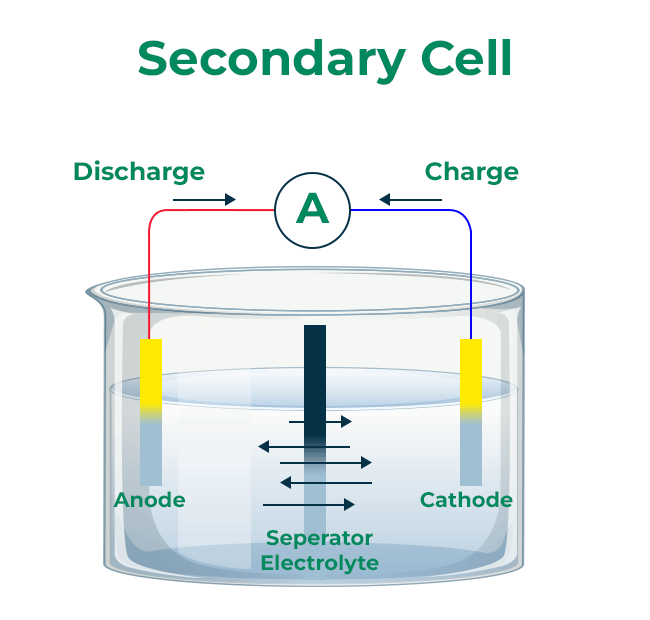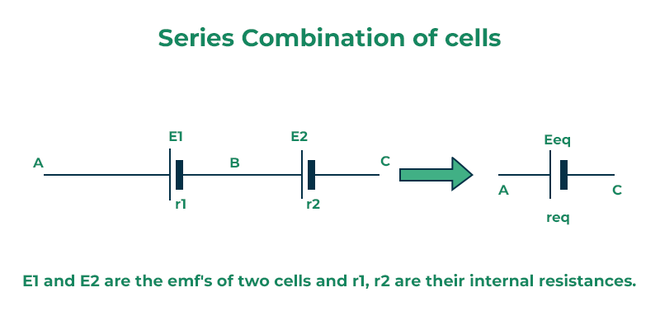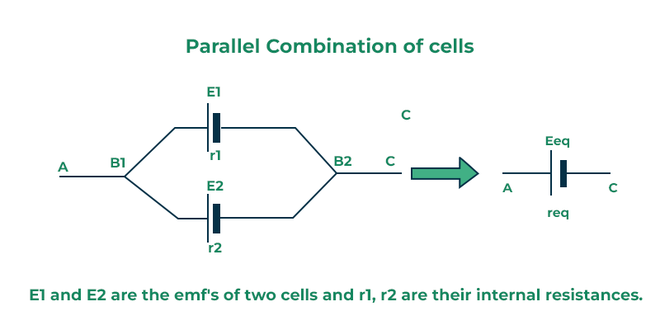An electric cell is an electrical power supply that generates electrical energy from chemical reactions, it is simply a device that is used to maintain the electric current. The electric cell was invented by Alessandro Volta in 1799. Each cell consists of two ends called terminals. The metal cap on each side of the cell is the positive terminal, while the metal disc on the other side is the negative terminal of the cell. It is used to generate electricity and generate chemical reactions with the help of electricity. An Electric cell is a single-unit device in which chemical energy is converted into electrical energy.
What is an Electric Cell?
An electric cell is a device that is used to convert chemical energy to electrical energy. The cell comprises – two electrodes and an electrolyte. Electrodes are made of materials that participate in chemical reactions with the electrolyte. It consists of some chemicals called electrolytes and has two terminals referred to as electrodes. In a cell chemical reaction oxidation-reduction happens between the electrodes and the electrolyte frees more electrons in one electrode than it does in the other.
The negative terminal called the anode gains more electrons while the positive terminal (called the cathode) loses electrons. This exchange of electrons creates a potential difference between the electrodes that allows electricity to flow whenever connected to the outer circuit.

Electric Cell
It has two terminals, which are made up of metal: one terminal is positive (+), while the other one is negative (-). When the two terminals are connected to an electrical device, electric current flows through it. An electrochemical cell consists of electrodes namely cathode and anode. The non-spontaneous reaction is controlled by an external source of current. The decomposition of an electrolytic solution by passing current, which results in the liberation of corresponding gases is known as electrolysis. Therefore, an electric cell is a device used to generate electricity, or to make chemical reactions by applying electricity.
Key Terminologies of Electric Cell
Some of the key defines of electric cell are :
- Production of Electricity in Cell : An electric cell produces a small amount of electricity from chemicals stored inside it. When the chemicals in the electric cells are used up, the electric cells stop producing electricity.
- Terminal: All types of electric cells have two terminals, a positive terminal and a negative terminal. In a dry cell used in our homes, the central carbon rod is the positive (+) terminal and the zinc contained is the negative (-) terminal.
- Chemical Reaction: In electric cell a chemical reaction takes place between the anode and cathode to produce electrical energy. The chemicals inside the electric cell are chosen to provide high voltage potential and for the flow of electrons.
- Voltage: The specific voltage of an electric cell is decided by its design and chemical composition. Common household battery voltages are 1.5 volts (AA and AAA batteries, for example) and 9 volts.
- Battery : A battery is created by connecting multiple electric cells together. More electrical energy can be produced by batteries, which is used in a variety of gadgets and electric cars.
Electric Cell Components
Electric cell contains three parts, anode (- electrode), cathode (+ electrode), and electrolyte.
- Electrodes: The electrodes are the two metal plates in the cell. One electrode is the cathode, which is the positive terminal of the cell, and the other is the anode, which is the negative terminal.
- Electrolyte: The electrolyte is a liquid or gel that contains ions. It allows the flow of electric charge between the electrodes.
- Separator: The separator is a barrier that prevents the two electrodes from touching and shorting out the cell.
The positive and negative sides, i.e. cathode and anode, are attached to an electrical circuit. These two electrodes are dipped in an electrolyte which can either be a liquid or dry powder. When this cell is connected to an external circuit, chemical reactions happen within the electrolyte. Due to these reactions, positive ions and electrons are generated near the negative electrode. The electrons flow towards the positive electrode from the external circuit while the positive ions move into the electrolyte.
The electrons recombine with the positive ions present in the electrolyte at the positive electrode. Thus, the circuit is complete, and our device starts working.

Electric Cell
Working of an Electric Cell
- The working of a Electric cell involves a chemical reaction called oxidation-reduction reaction. The reaction takes place between the cathode and the anode via the electrolyte. Due to the oxidation reaction, an electrode gets negatively charged, which is called the anode. And due to the reduction reaction, the other electrode, the cathode, gets positively charged.
- When two different reactive metals are dipped in the same electrolyte solution, there will be a movement of electrons between them. One metal will lose electrons while the other metal will gain electrons. A potential gradient is created between the two metal electrodes due to the difference in the concentration of electrons around them. This potential difference acts as a source of voltage for any electrical device. Then the electrons flow through the external circuit, which results in electrical energy.

Working of Electric Cell
Types of Electric Cell
Electric cells are divided into two categories based on the rechargeable and non-rechargeable type:
- Primary cell
- Secondary cell
Primary Cell
Primary Cell is a type of electrochemical cell that is designed to be used once and disposed of or discarded, after its useful life. They lack fluid inside and are hence referred to as Dry Cells. They have a mechanism of an irreversible chemical reaction and due to their high charge density, they discharge slowly. A primary cell is not rechargeable and cannot be restored to its original charge once it has been depleted. Primary cells are used in a wide range of applications, including portable electronic devices, flashlights, and other devices that require a portable power source. Some examples of primary cells include alkaline cells, zinc-carbon cells, and lithium primary cells.
- The electric cell which cannot be recharged electrically are called primary cell. The original state of electric cell cannot be brought back by passing electrical energy through cell from any external source after cell is discharged.
- These are electric cells that cannot be recharged electrically.
- This cell can only be replenished by the renewal of the active materials(means putting pallets of ammoniac into the electrolyte).
.jpg)
Primary Cell
Advantages of Primary cell
- These are Cheap
- Requires little maintenance
Disadvantages of Primary cell
- Cannot be recharged electrically.
- Incapable of supplying heavy currents
- More cells are needed for a give output
- The cell cannot be used continuously due to effects of polarization
- Has a high internal resistance due to resistance of the pates and the electrolyte.
Uses of Primary cell
- Flash lights
- Watches
- Radios
- Clocks
- Remote control
- Toys, games, etc.
Examples of Primary cell: Examples of Primary cell are Voltaic cell, Daniel cell, Leclanche cell, manganese-alkaline cell, mercury button cell etc.
Secondary Cell
Secondary Cell, also known as a rechargeable cell, is a type of electrical cell that can be recharged and used multiple times. Secondary Cells consist of wet molten ions and they undergo reversible chemical reaction mechanisms. Unlike a primary cell, which is used once and then disposed of, a secondary cell can be recharged by running an electric current through it in the opposite direction of the current that is used to discharge it. Common examples of secondary cells include lead-acid batteries, nickel-cadmium batteries, and lithium-ion batteries. These types of cells are used in a wide range of applications, including powering portable electronic devices, vehicles, and backup power systems.
- The electric cell in which chemical process is reversible are called Secondary cell. The original chemical state of the cell can be brought back by passing electrical energy through cell from any external source.
- These are electric cells that may be recharge electrically.
- Chemical energy is converted into electrical energy when the cell is discharging and electrical energy is converted into chemical energy when the cell is being charged.

Secondary Cell
Advantages of Secondary Cell
- It can be rechargeable
- Capable of supplying heavy current
- Higher voltage per cell
- Lower internal resistance
- Longer lasting
Disadvantages of Secondary Cell
- They are expensive
- Lacks mechanical strength
- Self discharging
- Plates shed easily
- Require careful maintenance
Uses of Secondary Cell
- Used in extreme of high temperature and in conditions where vibration is experienced.
- Stand by supplies
- Motor vehicles
Examples of Secondary Cell: The examples are Lead acid accumulator, alkali cells etc.
Electromotive Force of Electric Cell
Electromotive Force or EMF is the work done by the per unit charge while moving from the positive end to the negative end of the battery. It can also be defined as the energy gain per unit charge while moving from the positive end to the negative end of the battery.
- The battery or the electric generator generates the electromotive force which causes the current to flow in the external circuit. These devices use another form of energy and convert them to electric energy.
- Electromotive Force is the electric potential generated by the battery or any electric source which allows the current flow to in the circuit.

EMF of Cell
Electromotive Force or EMF is calculated using the formula,
ε = V + Ir
where,
- ε is the Electromotive Force
- V is the Voltage of the Battery
- I is the Current in the Circuit
- r is the Internal Resistance of the Battery
The above formula is used to calculate the EMF of the battery or cell. EMF of the cell is equal to the end potential difference of the cell when no current flows through the circuit.
Combination of Electric Cells
Two or more voltage sources are used in different combinations to produce the desired value of voltage and current. These batteries can be connected in two basic types of combinations. These combinations make up the foundation for all other combinations. These two combinations are:
- Series Combination
- Parallel Combination
Series Combination of Cells
A battery is a group of cells. Two cells are given which are connected in series with each other, the negative terminal of the first cell is connected to the positive terminal of the second cell and the other terminal is free in either of the cells. E1 and E2 are the emf’s of two cells and r1, r2 are their internal resistances. If the potential at the three points A, B, and C is denoted by V(A), V(B), and V(C). Then the potential differences across these cells are given by V(A) – V(B) and V(B) – V(C).

Series Combination
VAB = V(A) – V(B) = E1 – Ir1
VBC = V(B) – V(C) = E2 – Ir2
Thus, the potential difference between the points A and C will be given by,
V(A) – V(C) = [V(A) – V(B)] – [V(C) – V(B)]
⇒ V(A) – V(C) = E1 + E2 – (Ir1+ Ir2)
⇒ V(A) – V(C) = E1 + E2 – (Ir1 + Ir2)
To replace this combination of cells with a single equivalent cell of emf value Eeq and req. Then,
⇒ Eeq – I(req) = E1 + E2 – (Ir1 + Ir2)
Eeq = E1 + E2 and req = r1 + r2
This can be extended to any number of cells, Eeq = E1 + E2 + … and req= r1 + r2 + …
Parallel Combination of Cells
A battery is a group of cells, Two cells are connected in Parallel Combination of batteries, in this combination cells are connected in parallel. E1 and E2 are the emf’s of two cells and r1, r2 are their internal resistances. This time, the current flowing through each cell is different and they are denoted by I1 and I2 while the total current flowing through the circuit is denoted by I and is the sum of both of the two currents. i.e. I = I1 + I2 .

Parallel Combination
Let V(B1) and V(B2) denote the potential at B1 and B2. Consider both the cells one by one,
V = V(B1) – V(B2) = E1 – I1R
V = V(B1) – V(B2) = E2 – I2R
I = I1 + I2
I = ([Tex](\frac{E_1 – V}{R_1}) +(\frac{E_2 – V}{R_2})
[/Tex]
I =[Tex] \frac{E_1}{R_1} + \frac{E_2}{R_2} – V(\frac{1}{R_1} + \frac{1}{R_2})
[/Tex]
Rearranging the equation to take out the value of V,
V = [Tex]\frac{E_1r_2 + E_2r_1}{r_1 + r_2} + I\frac{r_1r_2}{r_1 + r_2}
[/Tex]
To replace this combination of cells with a single equivalent cell of emf value Eeq and req. Then,
[Tex]\frac{1}{r_{eq}} = \frac{1}{r_1} + \frac{1}{r_2}
[/Tex]
[Tex]\frac{E_{eq}}{r_{eq}} = \frac{E_1}{r_1} + \frac{E_2}{r_2}
[/Tex]
Internal Resistance of Electric Cell
When a battery fails, it is typically because it has built up enough internal resistance that it can no longer supply a useful amount of power to an external load.
- Every cell has an internal resistance due to the resistance of the plates and the electrolyte
- when cell is connected to an external circuit current flows and there is a voltage drop across the internal resistance this is why Potential difference is less than the EMF because of internal resistance
Calculating the internal resistance of a electric cell when given the current e.m.f and p.d:
r = e.m.f – p.d
Advantages of Electric Cell
- Electric cells are light so they are portable.
- They produce a very small amount of electricity so they are perfectly safe and one can handle them without receiving electric shocks.
- They are not very costly.
- They do not contain any liquid chemicals that can be spilled.
Uses of Electric Cell
- Electric cells are used in consumer electronics, including smartphones, laptops, and portable speakers.
- Electric cells are used in power electric vehicles, such as cars and buses.
- Electric cells are used in power medical devices such as pacemakers and insulin pumps.
- Electric cells are used to provide backup power to buildings and other critical infrastructure, such as hospitals and data centers.
Conclusion
In this article we have seen the electric cell and components and working of electric cell and different types of electric cell and advantages and applications of electric cell. Electric cell has many applications which we use mostly in our daily life. Electric cell plays an important role in our daily life. We have learnt combinations of Electric cell and we have learnt emf of an electric cell .we have seen the calculation of internal resistance of an electric cell. We have learnt the advantages of primary cell and secondary cell in this article. Electric cell has many different applications which are very useful and we use these electric cells in our day-to-day applications.
FAQs on Electric Cell
What is the lifespan of Electric Cell ?
The lifespan of an electric cell depends on the type of an electric cell, the amount of capacity in it, and how often it is used. For example Alkaline cells can last for several years. But some electric cells like lead acid cells needs to be recharged.
How can we recycle Electric Cell?
We can recycle electric cells by using recycling centers ,because most of the electric cells contain different toxic chemicals which can be harmful to environment if they are not disposed properly. so with the help of recycling centers they can safely extract the materials from used cells .
Can Electric Cells explode?
Yes, Electric cells can explode if they are short-circuited or if those are exposed to high temperatures. Because it can cause the electrolyte to heat up and create a buildup of pressure that can rupture the electric cell.
Which electrolyte liquid is used in Electric Cell?
Electrolyte liquid is used in electric cell are Ammonium Chloride, Manganese dioxide and carbon black.
Share your thoughts in the comments
Please Login to comment...